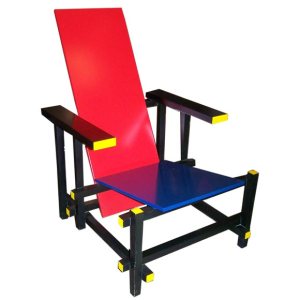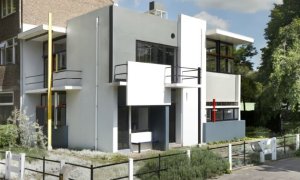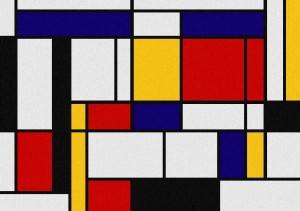De Stijl, Dutch for “The Style”, also known as neo-plasticism, was a Dutch artistic movement founded in 1917 in Amsterdam.
De Stijl was a casual organization of Dutch painters, architects and sculptors, as well as the journal which the group used to propagate their ideas on abstract art and design.
To begin with, De Stijl promoted Mondriam’s artistic concept of Neo-Plasticism, but from 1921 onwards Van Doesburg also promoted Dada ideas and a revised form of Neo-Plasticism known as Elementarism. This led to Mondrian’s departure from the group. One of the more influential of the avant-garde modern art movements, De Stijl had its greatest impact on architectural design see for instance Le Corbusier(1887-1965) and Mies van de Rohe(1883-1969) and the applied arts, notably typography and furniture design.
Principles and influences
The name De Stijl is supposedly derived from Gottfried Semper’s Der Stil in den technischen und tektonischen Künsten oder Praktische Ästhetik (1861–3), which Curl[3] suggests was mistakenly believed to advocate materialism and functionalism. In general, De Stijl proposed ultimate simplicity and abstraction, both in architecture and painting, by using only straight horizontal and vertical lines and rectangular forms. Furthermore, their formal vocabulary was limited to the primary colours, red, yellow, and blue, and the three primary values, black, white, and grey. The works avoided symmetry and attained aesthetic balance by the use of opposition. This element of the movement embodies the second meaning of stijl: “a post, jamb or support”; this is best exemplified by the construction of crossing joints, most commonly seen in carpentry.
In many of the group’s three-dimensional works, vertical and horizontal lines are positioned in layers or planes that do not intersect, thereby allowing each element to exist independently and unobstructed by other elements. This feature can be found in the Rietveld Schröder House and the Red and Blue Chair.

Legacy
Although it is fair to say that De Stijl’s impact was greatest on the theory (rather than the practice) of modern art, it had significant influence on the development of geometric painting, as well as architecture and applied art. This influence is seen most clearly in the work of the Bauhaus Design School and in the International style of modern architecture, which was taken up by numerous American architects under the influence of ex-Bauhaus designer Ludwig Mies van der Rohe, who emigrated to Chicago.
Influence on architecture
The De Stijl influence on architecture remained considerable long after 1931; Mies van der Rohe was among the most important proponents of its ideas. Between 1923 and 1924, Rietveld designed the Rietveld Schroder House, the only building to have been created completely according to De Stijl principles.

